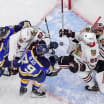As part of the NHL Centennial Celebration, renowned Canadian artist Tony Harris will paint original portraits of each of the 100 Greatest NHL Players presented by Molson Canadian as chosen by a Blue Ribbon panel. NHL.com will reveal two portraits each Monday in 2017.
This week, the portraits of goaltender Bill Durnan and forward Sid Abel are unveiled in the 44th installment.
Durnan, Abel portraits unveiled
Color paintings of 100 Greatest NHL Players will be revealed on NHL.com every Monday in 2017

By
NHL.com @NHLdotcom
Bill Durnan, a contemporary of Sid Abel, spent all of his brief-but-brilliant career with the Montreal Canadiens. He made his NHL debut at age 27, won the Vezina Trophy and was selected for the NHL First All-Star Team six times in seven seasons, then retired in 1950. No goaltender in NHL history has been so consistently dominant.
At 6-foot, 190 pounds, Durnan would be relatively small by today's standards for NHL goaltenders. But back then, he was a large man playing what was traditionally regarded as a small man's position. Though big goalies were thought to move too slowly, Montreal general manager Tom Gorman noted that Durnan was "big as a horse, but nimble as a cat."
One of his trademarks was the ability to wield his stick with either hand, enabling him to protect the short side of the net regardless of where opposing shooters attacked.
"He would hold his stick in both hands when the other team was heading his way, then switch it to one hand or the other, depending on which side the play was coming from," said Dick Irvin, the famed broadcaster whose father, Dick, was Durnan's coach in Montreal.
Though Durnan battled a nervous condition that worsened as his career went on, his teammates respected his skills and leadership. He succeeded Toe Blake as captain of the Canadiens in 1948, becoming the last goaltender allowed to wear the "C" on his jersey; the following season, the NHL prohibited goaltenders from becoming active captains.
In the end, the pressure was too much. He retired in 1950 after leading the Canadiens back to prominence with four consecutive first-place finishes, three trips to the Stanley Cup Final and two Cup championships.
"Although he always maintained he hadn't suffered some form of nervous breakdown, not many people believed him," Irvin wrote. "He never played another game. He's still considered one of the best, but had Bill Durnan's career started earlier, he might have earned the nod as the greatest of them all."
In his
NHL100 profile of Durnan
, Hackel wrote about the goaltender's arrival in Montreal:
"Durnan played with senior amateur teams in northern Ontario's mining region, where he'd found steady work in the mines during the Great Depression. At 24, he was the goaltender for the 1940 Kirkland Lake Blue Devils, who swept the Calgary Stampeders in three games to win the Allan Cup, Canada's senior amateur championship. That's when the Montreal Royals recruited him, the owner enticing Durnan with an accounting job in his steel foundry. Durnan was now in the orbit of the Canadiens, playing in the Forum and distinguishing himself regularly.
"Dick Irvin began coaching the Canadiens when Durnan signed with the Royals and, as his son Dick wrote in 'In The Crease,' 'The most frustrating of the many frustrating experiences (my father) endured during his first three seasons in Montreal was watching Durnan play his home games for the Royals right in the Forum. It was obvious the amateur team had much better goaltending than the professional team that played in the same building.
"When [Canadiens goaltender Paul] Bibeault entered the armed forces in 1943, Gorman didn't have to look far for a replacement.
"Initially, Durnan wasn't especially interested, recalling how the Leafs mistreated him. But Gorman persisted and signed Durnan just minutes before the first game of the 1943-44 season on Oct. 30. Durnan was spectacular that night, a 2-2 tie against the Boston Bruins, and went undefeated in his first 14 games, winning 11 and tying three, setting an NHL record for longest unbeaten streak to start a career."
Artist Tony Harris said Durnan's gloves were unlike any others he'd ever seen.
"The first thing I noticed when looking at material for Bill Durnan's painting was his unique, and I mean unique, trapper-blocker setup," he said. "The gloves doubled as both. All I could think was how entertaining he must have been to watch."
Abel's Hall of Fame career with the Detroit Red Wings had two distinct phases -- before and after he served in Canada's military during World War II.
Abel, a speedy center, became a full-time member of the Red Wings in 1939 and had a breakout season in 1941-42, finishing fifth in the NHL in scoring, being selected a Second-Team All-Star and becoming a fan favorite. He was named captain during the summer of 1942 and led the Red Wings to a first-place finish and a Stanley Cup championship with 13 points in 10 playoff games.
But later in 1943, Abel enlisted in the Royal Canadian Air Force, putting his NHL career on hold until late in the 1945-46 season. He returned to a game that was faster because of the addition of the red line and was slowed by injuries and illness. There was concern that at age 28, his career might be done.
Instead, it was just beginning.
Abel spent the summer of 1946 getting into better shape and had 48 points (19 goals, 28 assists) playing on a line with Ted Lindsay on his left and Pete Horeck on his right, with 18-year-old rookie Gordie Howe taking occasional turns in Horeck's spot.
In 1947-48, Howe joined Abel and Lindsay to form what became known as "The Production Line." In 1948-49, Abel and his linemates scored 66 goals and helped Detroit begin a stretch in which it won the Prince of Wales Trophy (then given to the first-place finisher during the regular season) a record seven consecutive seasons.
The trio finished 1-2-3 in the NHL scoring race in 1949-50, then won the Stanley Cup in 1950 and again in 1952, after which he requested a trade to the Chicago Blackhawks, for whom he served as a player-coach before retiring after playing three games in 1953-54. He finished with 472 points (189 goals, 283 assists) in 612 games during a low-scoring era.
Abel went on to a long and successful career as an NHL coach and executive, as well as a color commentator on Red Wings' radio and television broadcasts.
''There was never any question about his leadership,'' Howe said after Abel died at age 81 on Feb. 8, 2000. ''Sid was very much respected. I learned a lot from him from just listening. When I was around Sid, that's the way it was. He was our captain and leader."
In his
NHL100 profile of Abel
, author Stu Hackel recounted Abel's start with the Red Wings:
"He had come to Detroit from his hometown of Melville, Saskatchewan. The man who spotted his well-rounded hockey talent was Red Wings scout Goldie Smith, Melville's postmaster, who in 1924 had discovered Eddie Shore. But Abel's road to stardom required dodging a few potholes.
"At Red Wings training camp in 1937, coach/general manager Jack Adams liked him but had concerns that 19-year-old Abel might be vulnerable at 155 pounds. After another year in junior hockey, his play at Red Wings camp in 1938 led Adams to call Abel 'the best recruit in camp.' He began his pro career with Detroit's Pittsburgh Hornets farm team, with former Red Wings captain Larry Aurie as coach. Aurie helped refine Abel's game and his leadership qualities.
"Abel became a full-time member of the Red Wings in the fall of 1939 until a shoulder injury curtailed his season and he landed back in the minors. By the time the 1940 playoffs arrived, he had returned to Detroit, where his aggressive play despite a shoulder issue further impressed Adams. Abel had the offseason to prepare for the 1940-41 season, when he established himself with 11 goals and 22 assists. He was second on the team in scoring and tied for 17th in the League.
"Abel broke out the following season. Adams shifted him to left wing on a line with center Don 'The Count' Grosso and Eddie Wares. Each had struggled with injuries on his path to the NHL, so they were dubbed 'The Liniment Line.' Abel finished fifth in the League in scoring, with 49 points in 48 games, and helped Grosso to his best season (53 points, third most in the NHL). He was selected to the NHL Second All-Star Team as a left wing. Also, enthusiastic crowds returned to Detroit's red-bricked Olympia for the first time since the days when Aurie and his linemates Marty Barry and Herbie Lewis helped lead the Red Wings to the Stanley Cup in 1936 and '37.
"One of the League's fastest skaters, Abel became a fan favorite, not just for his offense but also his hustle. Detroit employed an aggressive dump-and-chase, forechecking style, and Abel was a main cog in the scheme. It worked well, and the Red Wings appeared poised to bring the Stanley Cup back to Detroit in the spring of 1942. But after jumping out to a 3-0 lead against the Toronto Maple Leafs, the Red Wings collapsed, losing their composure and the next four games. During the painful offseason, Adams made changes and selected Abel -- 24 years old and with only two full NHL seasons of experience -- as the new captain."
Harris said he took a little artistic license in painting Abel's picture.
"I had difficulties finding a suitable image of Sid Abel and finally found this one," he said. "The photograph was taken very early in his career, so I took the liberty of adding the 'C' that he would earn latter."
Bill Durnan

Sid Abel


















